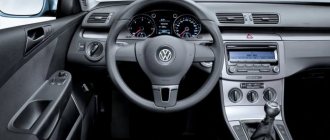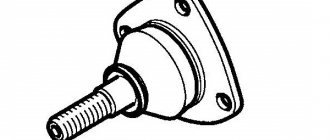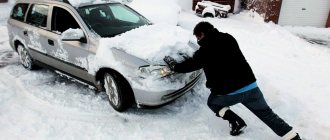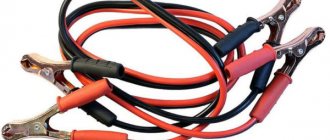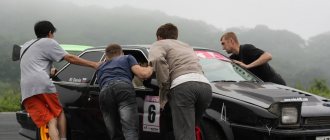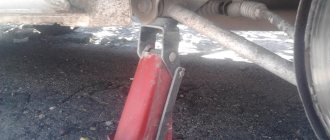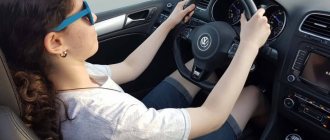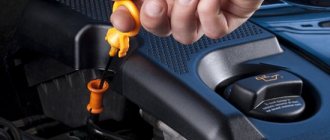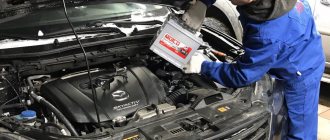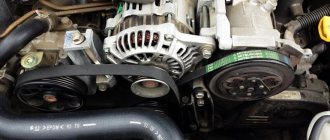Drivers note that every year the number of cars on city roads increases, and it becomes more difficult to find a place for long-term parking. Knowing how to park properly can help save time and make it possible to fit even in crowded parking lots. Novice motorists are afraid that they might hit nearby cars or damage their vehicle, so they often hire a driving instructor or watch video lessons to learn how to park correctly.
Parallel parking rules
One of the most important skills for a driver is the ability to parallel park a car in a confined space. Instructors often show two options: forward and backward.
Forward travel
To successfully park in front, the driver must follow the following rules:
- you need to move forward parallel to the row in which you need to park, remembering to turn on the right turn signal. You need to drive at a speed not exceeding 4 kilometers per hour;
- you need to remember that the distance between the right side of the car and the parked car should be 50 centimeters, it is better not to drive closer;
- when the middle pillar of the car reaches the front bumper of the car parked in the parking lot, you can turn the steering wheel to the right, at this time the vehicle will begin to drive into the right road pocket;
- the car will be located at approximately 45 degrees from the curb. At this moment, you need to turn the steering wheel all the way to the left. It turns out that the car will start to leave the parking space, while the rear of the car will move into the pocket.;
- after the car moves along the curb, the driver needs to align the steering wheel and drive the required distance to the car parked in front without moving the wheels. You should only move straight ahead.
Reverse
To use the method, you need to slow down, find a suitable place, and act according to the instructions:
- the driver needs to remember that to park he needs at least 1.5 meters from the length of his car. During the maneuver, the lights automatically turn on;
- after engaging reverse, you should carefully look in the left mirror and check if anyone is moving along the road in the same direction; if you can see an approaching car, then you should let it pass, and then return to the maneuver;
- you need to stop to the side of the parked car in front, the distance to the car should not exceed 70 centimeters;
- it is necessary to turn the steering wheel as far as possible towards the curb and move backward until the reflection of the headlight of a vehicle parked behind appears in the side mirror;
- the front part of the car appears on the road, and the rear part of the car goes deep into the pocket;
- the next step is to return the steering wheel to its original position and move forward until the wheels are at the intersection mark with the car in front;
- the driver should turn the steering wheel all the way away from the curb, after which the car begins to level;
- If the left headlight of the car behind is reflected in the left mirror, then the driver has sufficiently “hid” the vehicle in his pocket.
How to leave the parking lot?
Moving slowly down the middle of the corridor created by placing two parallel rows of parked cars, the car will be equidistant on both sides. Having identified a free area and without turning off the turn signal, you should drive past.
When the rear bumper reaches the side of the opposite car, which is farthest relative to the intended free space, you should stop. The rear view mirror will help you ensure alignment with the side of the distant vehicle. Next you need to turn the steering wheel. The wheels must be turned as far as possible, not forgetting the reverse gear.
Note to beginners: many novice drivers get confused which way to turn the steering wheel. The simplest way is to indicate with your thumb which direction you need to park the car and turn the steering wheel there. Moving slowly backwards, look in all directions. Having placed the car parallel to the distant and nearby car, side transport, you need to quickly stop and straighten the steering wheel. Further, when driving slowly into a parking space, it is important to take into account the possibility of other obstacles - fences, curbs, trees, poles, etc.
Many beginners park with their heads turned backwards. But it's not right. The streamlined bodies of modern cars have small rear windows at a steep angle, providing poor visibility. This applies to SUVs with rear windows placed too high.
Perpendicular parking
The method is widely used in the parking lots of large supermarkets, train stations and airport parking lots. To park the car, the driver can move in reverse or forward, depending on the situation. If the next parking space is empty, it is better to move forward so that there is no risk of hitting someone else’s car with your right wing.
If cars are parked on each side of the parking space, then it is better to start driving in reverse, as shown in the diagram.
To easily use the perpendicular parking method, you should pay attention to the following tips:
- you must try to drive up in such a way that the rear left corner of the car in front is at the rear right wheel of your car;
- The distance between the side of the car and the vehicle in front should be approximately half a meter. It turns out that the driver needs to stand parallel to the car in front at a distance of 50 centimeters;
- You need to carefully back away, twisting the steering wheel to the right;
- After you can see the headlight of the car standing behind you in the left mirror, you need to put the steering wheel straight and continue to slowly move backwards;
- you need to not track the moment when the rear left wheel of the car aligns with the left headlight of a parked car behind. At this time, you need to turn the steering wheel all the way to the left and continue to back away slowly;
- When the position of the car is parallel to other vehicles, curbs and fences, then it is worth stopping. If necessary, the car can be straightened.
Workout
How to park backwards between cars in the city? To do this you need to have enough experience. It is better to start training in a free space, where there will be enough room for maneuver, and there will be no risk of hitting other people's cars. Where is the best place to start doing exercises? Any vacant lot or free parking lot will do. If you don’t have such places at your disposal, you can go to a garage or an open-air supermarket parking lot. Then you should mark out the parking space, using cones to imitate standing cars. From there, it’s all up to you: but the more practice you have, the more confident you will feel during “real” parallel parking.
Reverse parking
Reverse parking causes a lot of difficulties for novice motorists; parking between two parked cars causes a lot of problems. Before driving, you need to assess the situation on the road behind the car. When using a rearview mirror, you need to remember that the reflection distorts the actual distance to objects. During the maneuver, you can turn back, using a mirror in parallel. This algorithm will help reduce the risk of accidents. Experienced drivers advise you to act according to step-by-step instructions:
- you need to drive a little forward, as far as available space allows. You can move parallel to other cars in the parking lot;
- you should stop so that the trunk of the car is approximately 50 centimeters from the car in the parking lot, after which you need to turn the steering wheel to the side;
- before performing the maneuver, you need to look to see if there are people or cars nearby;
- you need to slowly back away while looking in the mirrors;
- when the car is in the parking space, you need to return the steering wheel to its original position and straighten the wheels.
When parking in reverse, the car is maneuverable. A driver who knows the rules and has basic parking skills can easily park the car in the chosen place. It is important to try to park the car only in a place that corresponds in size to the dimensions of the car. The car must be parked so that in the mirror next to the passenger seat you can see the reflection of the left edge of the car that is parked behind.
Errors and problems in the exercise
The most common mistake when parallel parking is the wrong trajectory, due to which the car cannot fit into the designated space. This usually happens when a driver candidate forgets how many turns of the steering wheel need to be made to align the wheels when reversing and a corner cone appears in the rearview mirror.
Other drivers may hit the cones if they are trying to complete the task quickly. It would be more correct not to twist the steering wheel while driving, but to stop after completing each stage - the traffic police regulations allow such a task.
Some drivers do not press their right side against the right corner cone and the broken parallel line of the markings. As a result, when maneuvering in reverse, you can knock down the cones placed on the left side or cross the line with the dimensions of the car.
Parallel parking is difficult to master, but the driver needs this skill. This skill will be tested by traffic police examiners, and in real conditions you will also have to park in a similar way. Therefore, it is better to take the time and bring the skills to complete the task to perfection.
Share on social networks:
More useful on the topic
How does driving school training work in 2022?
19.01.2022
How to obtain international rights in the Russian Federation in 2022
01.01.2022
Parking diagonally (herringbone)
Drivers call "herringbone" a parking method in which the vehicle is placed at an angle to the road. Many motorists like this method of parking the car due to the significant space savings. If car owners park their “iron horse” parallel to the highway, then only one car will be able to fit in the parking space. When motorists choose herringbone parking, 2-3 cars can fit in one space. The method prevents the car from being blocked by an unscrupulous driver who likes to stand close to a parked car.
The method is suitable for beginners who have recently gotten behind the wheel:
- When performing a maneuver, you need to take a lateral distance from the neighboring car of approximately 50 centimeters;
- when the side mirror of the car is next to the neighbor’s right taillight, you need to brake;
- you need to turn the steering wheel to the left and start to back away slowly;
- when the right headlight of the neighboring car appears in the mirror, you can start pressing on the brake;
- it is necessary to straighten the steering wheel and slowly back up, carefully twisting the steering wheel to the right;
- it is important to equalize the distance between neighboring cars, guided by the mirrors;
- The steering wheel must be placed straight.
Diagonal parking is permitted in adjacent areas, for example, in the courtyard of a residential building or in the parking lot in front of a store. You may find a parking sign on the road with an additional sign or with markings notifying drivers that it is possible to park in a herringbone pattern in this area. If there is a parking sign on the road without additional signs, then the driver needs to understand that he can only park parallel to this roadway. Violation of parking rules is punishable by a fine of 500 rubles.
Ask for help
When entering and leaving a parking space, the driver must maintain maximum concentration on the maneuvers. Side and interior mirrors help the person driving to keep the situation under control. It is also easy to observe the surrounding space by turning your head. Mirrors do not always allow you to see all obstacles. Some of them may be located below their level.
Both novice and experienced drivers should not hesitate to ask for help. Parking staff or other motorists will help keep the situation under control during departure. However, you need to remember that the help of third parties in no way relieves responsibility from the one who is driving.
Common parking mistakes
Motorists who do not know how to park correctly make a number of mistakes:
- They have a poor sense of the dimensions of their car. You need to know and feel the size of your car, and understand whether there is enough space to maneuver. To “hone” skills you need to practice;
- the bumper hits the curbs. When parking, motorists often cannot correctly assess how high the obstacle is, and bumpers end up overhanging. To avoid damage when parallel parking, you need to perform a number of exercises;
- stand too far or too close. Many novice motorists are afraid of damaging their rims and park the car too far from the curb, thereby interfering with other road users. There are drivers who, on the contrary, stand too close to the sidewalk and damage their discs;
- put on the car on a slope. To prevent the car from rolling away, it is better not to leave the vehicle on the roadway with a slope, otherwise there is a high probability of getting into an accident;
- choosing a parking spot. Before parking your car, you need to evaluate the parking space and decide whether the car can fit in the parking space and whether the vehicle will interfere with other motorists.
In order not to make mistakes when parking, you need to think not only about yourself, but also about other drivers, whether the car is bothering them, and assess the risk of possible damage to your car.
Tips for beginners
How to learn to park backwards for those who have recently driven? Experts have some tips that may be useful for beginners:
- knowledge of theory can be of great help, so before you start practicing, carefully memorize the reverse parking scheme;
- if you are not confident in your abilities, train more;
- while driving, control everything that happens around you;
- do not forget about other road users, as well as pedestrians who may be near you;
- In order for other motorists to notice you in time, turn on your hazard warning lights before parking.
How to choose a parking spot
Before choosing a parking place, the driver needs to find out where he can park and where there is a parking ban. It is worth remembering that parking near pedestrian crossings is prohibited. Also, don’t take up a handicapped seat for no reason. It is important to carefully inspect the site and find a place where there is minimal risk that someone will damage the car while driving in and out of the parking lot. It is important to follow the law and traffic rules, and not be afraid to learn new things.
When choosing a parking spot, you should pay attention to the visibility and adjust the side mirrors and the mirror located in the cabin properly. It is better for novice drivers not to go to places where cars in the parking lot resemble “sprats in a can”, and it is better to park the car a little further and feel confident behind the wheel. It is worth paying attention to the markings in the parking lot; they make it easier to park your car properly.
Note! Drivers often forget that a comfortable seating position plays a big role when parking. You shouldn’t lower your back too much and ride almost lying down. The instrument panel and steering wheel should not block your view.
conclusions
Every driver should know how to properly park backwards between cars. This makes life much easier and helps you park your car in free space quickly and accurately. As with any activity, practice is required in this area. For experienced drivers, parallel and perpendicular parking does not cause any difficulties; they can easily get into even small spaces. But if you are driving recently, then you should be careful and attentive while driving, and also learn the theory and scheme of reverse parking in advance.
Parking training exercises
To improve your parking skills, you can go to a race track and do a number of exercises:
- parallel parking: the driver must stand as close as possible to the edge of the area or to the cones without hitting the equipment with the right wheel;
- Reverse parking: the driver needs to drive the right side of the car as close as possible to the installed cone.
- leaving a parking space: the driver needs to leave the space without hitting the training markings;
- driving into the garage is one of the students’ least favorite exercises, but it is one of the most effective. After training, the driver will not only be able to drive into narrow spaces, but will also have a good feel for the dimensions of the car.
For training, you need a flat, paved area and equipment (you can use traffic cones and old tires as guides).
Before you start driving
How to reverse out of a parking lot without harming yourself and others? To begin with, you should map out your route. A beginner should think in advance about how to get out, how to taxi, where to turn. Next, you should look at both sides of the driveway (right and left), as well as the space behind the car. This will help ensure there is no traffic in the parking lot.
If the exit is clear, you are allowed to start moving. Be sure to turn on the appropriate turn signal.
In which gear should you leave the car in the parking lot (for manual transmission)
When parking a car with a manual transmission, a driver should adhere to the following rules:
- When parking on a downhill slope, you must put the vehicle in reverse gear and immediately apply the handbrake. If the car rolls forward, reverse gear will stop the process and prevent the vehicle from moving due to the fact that the crankshaft will rotate in the opposite direction;
- When parking, even on a slight incline, the driver needs to engage first gear and raise the handbrake.
The driver needs to remember that when leaving the car, it is better to turn the wheels in the opposite direction from the roadway, especially if there is no curb in this place.
Before performing the maneuver, you need to make a parking plan in your head, and if you plan to disembark passengers, then you need to leave a space up to the curb. It is important to take your time and remain calm, even if something doesn’t work out the first time.
How to act
For some motorists, getting out of the parking lot onto the road causes certain difficulties.
There are some useful recommendations in this regard:
- if you cannot assess the situation on your own when leaving, ask for help from a passenger or a random passer-by;
- the help of another person will allow you to drive out safely and also give signals to other drivers;
- It’s better not to back up if the weather is bad;
- It is also not recommended to engage reverse gear when there is low visibility outside.
But there is also a universal recommendation that helps quite often.
Yes, it is important to understand that parking arrangements do not always allow this.
But objectively, the best solution would be to park in such a way that when leaving, the driver is required to drive forward. In other words, you should park in reverse. This will allow you to drive forward, in forward gear, and thereby minimize the likelihood of a collision with other road users in the parking area.
